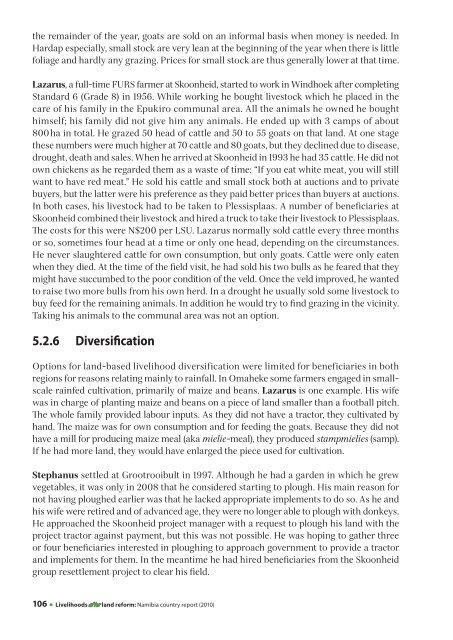Namibia country report
Namibia country report
Namibia country report
- No tags were found...
You also want an ePaper? Increase the reach of your titles
YUMPU automatically turns print PDFs into web optimized ePapers that Google loves.
the remainder of the year, goats are sold on an informal basis when money is needed. InHardap especially, small stock are very lean at the beginning of the year when there is littlefoliage and hardly any grazing. Prices for small stock are thus generally lower at that time.Lazarus, a full-time FURS farmer at Skoonheid, started to work in Windhoek after completingStandard 6 (Grade 8) in 1956. While working he bought livestock which he placed in thecare of his family in the Epukiro communal area. All the animals he owned he boughthimself; his family did not give him any animals. He ended up with 3 camps of about800 ha in total. He grazed 50 head of cattle and 50 to 55 goats on that land. At one stagethese numbers were much higher at 70 cattle and 80 goats, but they declined due to disease,drought, death and sales. When he arrived at Skoonheid in 1993 he had 35 cattle. He did notown chickens as he regarded them as a waste of time: “If you eat white meat, you will stillwant to have red meat.” He sold his cattle and small stock both at auctions and to privatebuyers, but the latter were his preference as they paid better prices than buyers at auctions.In both cases, his livestock had to be taken to Plessisplaas. A number of beneficiaries atSkoonheid combined their livestock and hired a truck to take their livestock to Plessisplaas.The costs for this were N$200 per LSU. Lazarus normally sold cattle every three monthsor so, sometimes four head at a time or only one head, depending on the circumstances.He never slaughtered cattle for own consumption, but only goats. Cattle were only eatenwhen they died. At the time of the field visit, he had sold his two bulls as he feared that theymight have succumbed to the poor condition of the veld. Once the veld improved, he wantedto raise two more bulls from his own herd. In a drought he usually sold some livestock tobuy feed for the remaining animals. In addition he would try to find grazing in the vicinity.Taking his animals to the communal area was not an option.5.2.6 DiversificationOptions for land-based livelihood diversification were limited for beneficiaries in bothregions for reasons relating mainly to rainfall. In Omaheke some farmers engaged in smallscalerainfed cultivation, primarily of maize and beans. Lazarus is one example. His wifewas in charge of planting maize and beans on a piece of land smaller than a football pitch.The whole family provided labour inputs. As they did not have a tractor, they cultivated byhand. The maize was for own consumption and for feeding the goats. Because they did nothave a mill for producing maize meal (aka mielie-meal), they produced stampmielies (samp).If he had more land, they would have enlarged the piece used for cultivation.Stephanus settled at Grootrooibult in 1997. Although he had a garden in which he grewvegetables, it was only in 2008 that he considered starting to plough. His main reason fornot having ploughed earlier was that he lacked appropriate implements to do so. As he andhis wife were retired and of advanced age, they were no longer able to plough with donkeys.He approached the Skoonheid project manager with a request to plough his land with theproject tractor against payment, but this was not possible. He was hoping to gather threeor four beneficiaries interested in ploughing to approach government to provide a tractorand implements for them. In the meantime he had hired beneficiaries from the Skoonheidgroup resettlement project to clear his field.106 ● Livelihoods after land reform: <strong>Namibia</strong> <strong>country</strong> <strong>report</strong> (2010)
















